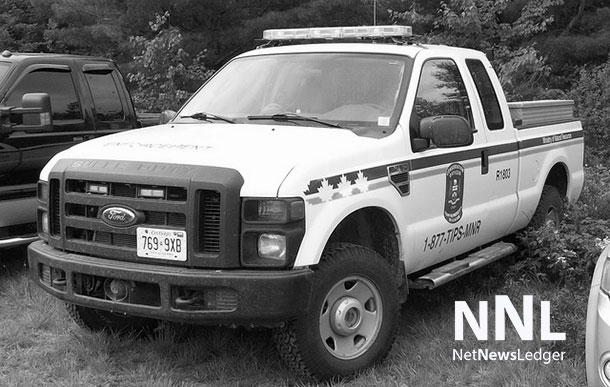THUNDER BAY – Special to NNL – OK, I’ll admit it; I have been among those who enjoy sitting on a beach chair, sipping a cool one and laughing at the boat ramp follies that take place at most ramps nearly every weekend, where ever you do your boating or fishing. It’s amazing how many ways boaters can find to bollix up the simple process of launching or loading their boats.
On the other hand, I’ll also admit to having been the bollixee more than a few times over a long boating career. And just when you think you know it all, that’s the day you’ll pull off the worst bonehead stunt ever.
Can you spell d-r-a-I-n-p-l-u-g?
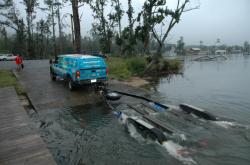 |
Avoiding problems at the ramp is a matter of having a mental checklist, and at the head of that list should be that you will not interfere with other boaters, particularly during times when the ramps are busy and the lines are long. Second is taking an organized, methodical approach; do everything the same way, every time, and problems will be rare. And third, if you’re new to launching your own rig, put in a bit of practice time at home in backing up your rig.
First, do no harm, as the physicians like to say (except when it comes to the patient’s wallet). When there are a lot of people wanting to use a ramp at the same time, as there surely will be late on a Saturday afternoon as supper time approaches, you have to do your part to keep the whole army creeping forward. (Or better yet, plan your boating ventures to avoid “rush hour” while you’re learning the skills that make launching and loading easy.)
To start, both the skipper and the first mate are going to have to forgo the pleasures of the barley in order to handle the loading procedures efficiently and calmly. Probably more problems result from intoxicated boaters than from any other single source at the ramps. (Just as a tiny aside, you are not supposed to be driving the boat, or the tow vehicle, if you’ve had more than a tiny whisper of the sauce, in any case. DWI or BWI, it’s all the same to the courts.)
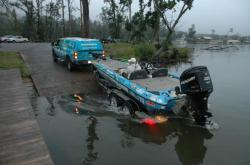 |
Second, you approach the ramp locked and loaded. That means tackle and gear are in some semblance of order so that you can easily move around the boat. You know where your bow and stern lines are; best is to have them already attached to the cleats, and of course all knots and tangles should be cleared. It’s a good idea to have a couple of bumpers at the ready, too, to cushion your boat from the dock, or from other boats in areas where the boats have to raft up waiting to load.
Get your tow rig into the line for the ramp, leaving a driver in the boat if possible. When it’s your turn, you put your trailer in the water, as promptly as possible. Yes, there is some art to backing in a trailer. It gets a lot easier if you put your right hand on the bottom of the steering wheel and NO MATTER WHAT HAPPENS, leave it there, remembering that if you move your hand right, the trailer will go right. Move your hand left and the trailer will go left. It’s best to learn to back up by watching the trailer in the rear view mirror. That way when you get old and stiff like me you won’t have trouble turning around to watch it. Start with the trailer straight, and make small corrections-it gets easy after a few hundred attempts.
Once the trailer is in the water, the boat driver brings the boat around. This works a whole lot better than waiting until you’ve worked through the lineup of boats before you go to get your tow vehicle-although, if you’re boating alone, you won’t have much choice, of course.
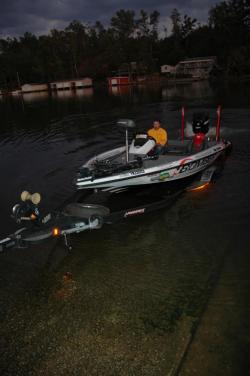 |
Success in loading the boat depends a lot on getting the trailer in the right depth of water. I like to back down far enough to wet the bunks, then pull forward until the front of these supports are several inches out of the water; for my Triton bass rig, that works just right. Wetting the carpet on the bunks allows the boat to slide on more easily. Other boat designs with deeper or shallower vees may take a slightly different approach, but this is something you can learn in a few trials, then repeat in the future.
Getting the boat on the trailer is sort of like backing the trailer; unless you’re fairly expert, it will work a lot better if you start with the boat completely lined up with the trailer bunks. Use the wind and the tide to help you get aligned, remembering that the bow of the boat will always swing faster than the stern.
Once you’re lined up, power ahead slowly but steadily, with enough authority to push the boat right up the bunks, across the bow rollers and snugged into the bow stop. Then your driver clips the bow strap into place, tightens it down and flips the ratchet lock so it can’t get away, and pulls you out. Make sure to shut off the outboard before this happens; particularly with quiet four-stroke motors, it’s not hard to forget they’re running. And once the boat is in position, trim up the motor a bit so that skeg and prop won’t hit the pavement as the boat comes clear of the water.
At times, if the boat comes an inch or two short of the stop, you can go ahead and pull the trailer up the ramp and out of the way, stop and then winch it that last inch. Once the boat is level, it will be easier to force it forward.
If the boat won’t ride up on the trailer, that means you don’t have the trailer in far enough; back it up a foot or two and all will be well. If it goes on but floats sideways over the fender, that means the trailer is in too deep; get the boat off, pull the trailer forward a foot or two, and try again. With the bunks properly adjusted to the shape of your hull, the boat will “want” to load down the center, provided you get the trailer in to the right depth.
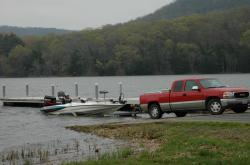 |
As soon as you’re loaded, you pull out and drive well clear of the ramp, so that the next boater can put his trailer in. Don’t stop to put on the tie downs, pull the drain plug or stow tackle until you get completely clear of the ramp!
Once you’re out of the way, now is the time to recheck the winch and ratchet, put on a bow chain and perhaps a stern strap, and secure anything aboard that may blow out on the drive home. If you have a long drive, you may want to give the trailer bearings a shot of grease, as well.
Launching is much easier. Prep the boat well away from the ramp-position your gear where you want it, unfasten the tie downs, INSERT THE DRAIN PLUG!, attach a bow line at least 10 feet longer than your trailer, tie it to the winch stand and ONLY THEN back the rig in until it just floats. Now unfasten the winch hook and back in until the boat floats clear-the line keeps it tethered. If you have “Boat Reins”, they can do the job of handling the lines for you-thanks to pro angler Denny Brauer for showing me that trick.
It all sounds like a lot to remember, and it is at first-but after you’ve done it a few hundred times, it’s all completely quick and natural. Except for that occasional trip when you will find yourself among the bolixee’s, of course.
By Frank Sargeant, Editor





